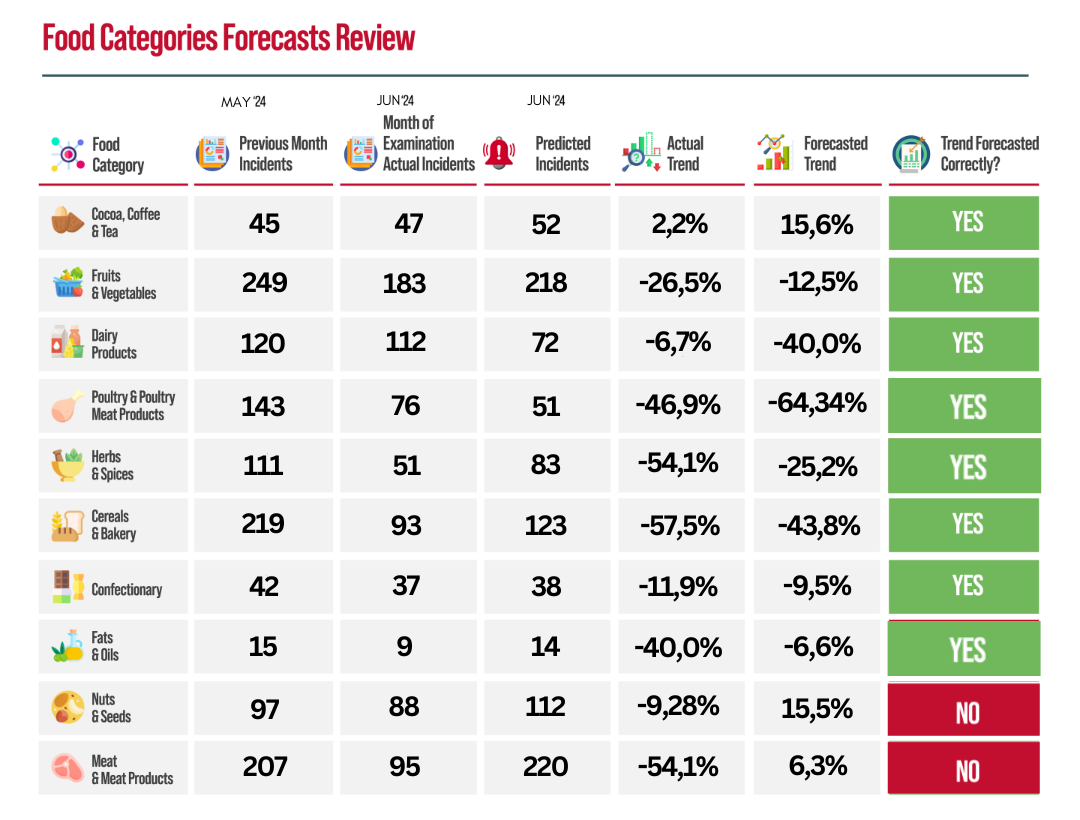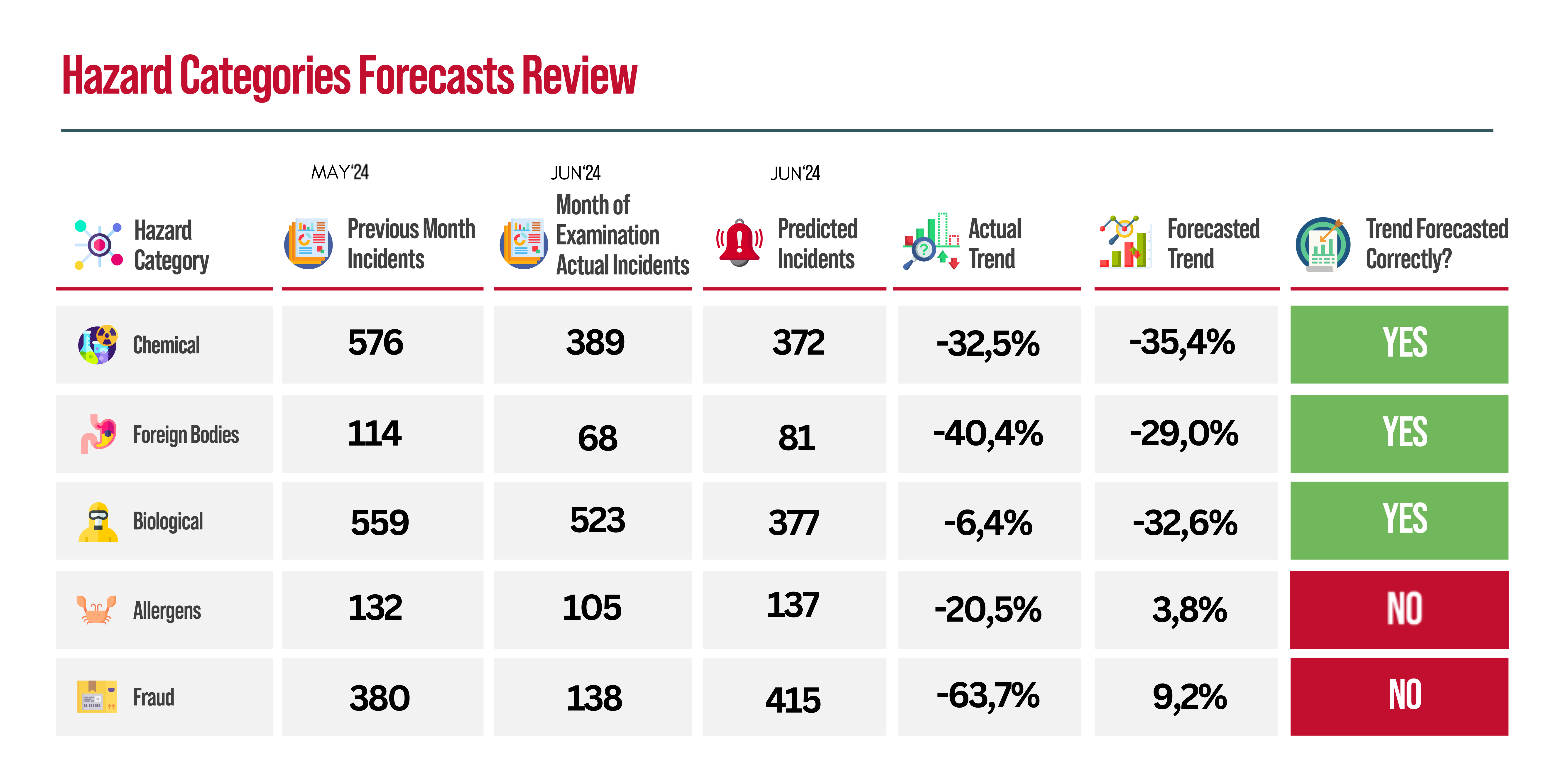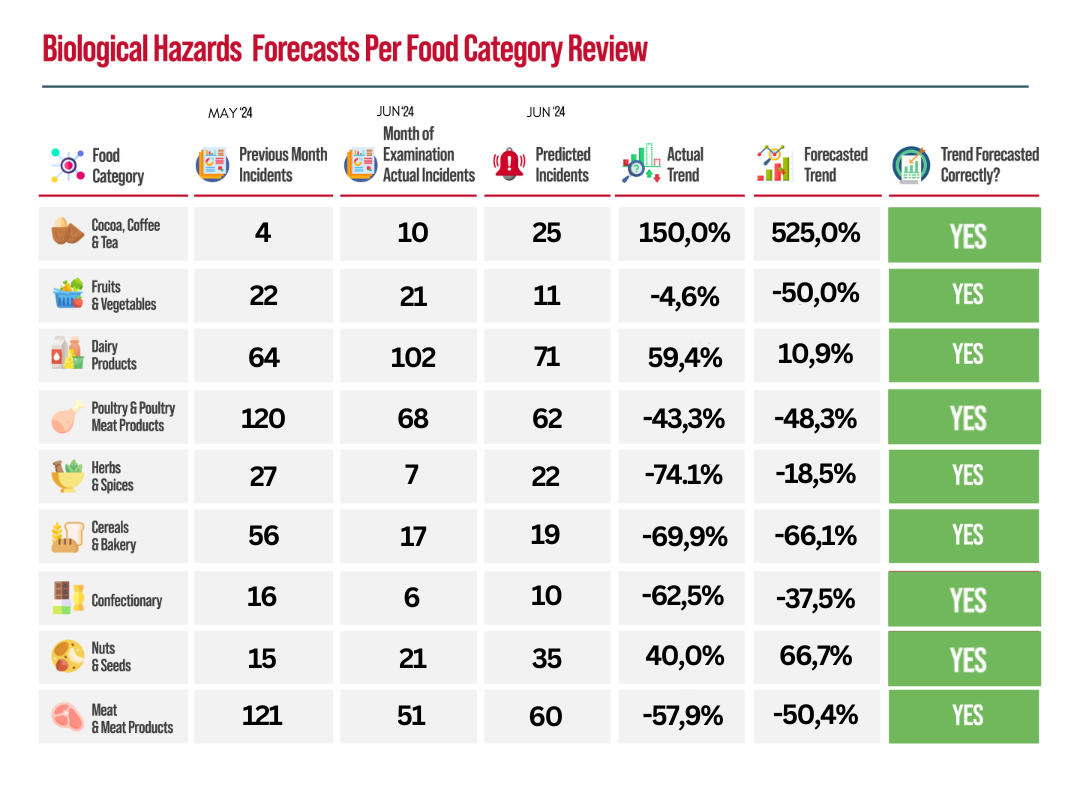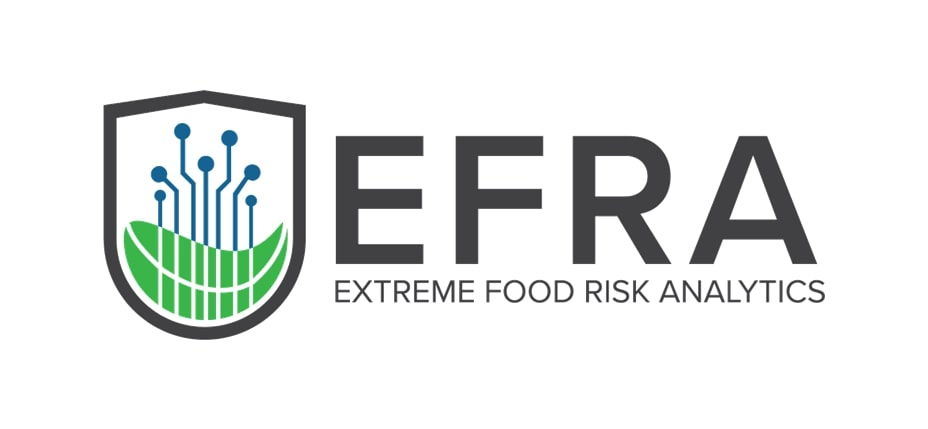
Monthly Forecasts Review: June
Another month, another addition to our Monthly Forecasts Review, the blog series where we review our monthly incident forecasts by looking closely at their performance over actual recorded incidents for the previous month, June.
In more detail, the review includes forecasts for 10 key food categories as well as the hazard trends forecasts for the top Biological, Chemical, Foreign Bodies, Allergens Hazard Categories as well as Food Fraud, focusing more on Chemical & Biological Hazard Forecasts for these 10 product categories.
How is the performance review conducted?
We compare the forecasted incidents trend for each food product category, hazard, and risk category from FOODAKAI, the AI-powered & predictive data analytics platform, versus the actual number of recorded incidents for that month.
FOODAKAI employs trend forecasting models that utilize different sources in order to predict future incidents and trends. Historical incidents, laboratory data, and weather data represent a few of the main sources that are leveraged in order to train the forecasting models. More specifically, trend forecasting takes advantage of multiple factors (more than 250 distinct factors) in order to produce robust generalized models and accurate predictions. With such forecasts food & beverage companies can enhance their early warning detection measures and proactively mitigate risks.
For our previous edition ─ the May report, read here.
Key Food Categories Forecasts Review
Firstly, let’s start with the overall incidents trend forecasts in 10 Key Food Categories for June.

FOODAKAI forecasted the incidents trend successfully in 8 out of the 10 key food categories: Cocoa, Coffee & Tea, Fruits & Vegetables, Dairy Products, Poultry & Poultry Meat Products, Herbs & Spices, Cereals & Bakery, Confectionary, and Fats & Oils products. The forecasts for the Nuts & Seeds and Meat & Meat Products category were not successful.
Highlights:
- In the Cocoa, Coffee & Tea, Poultry & Poultry Meat and Herbs & Spices products categories, FOODAKAI forecasted the trend successfully in each product category with a slight difference in the percentages of trend value.
- In the Fruits & Vegetables and Cereals & Bakery food categories, the platform forecasted with great accuracy the decreasing trends for both.
- In the Dairy products category, while the platform correctly forecasted the decreasing trend, it anticipated a higher decrease (-40,00%) than the actual (-6.7%).
- In the Confectionary category, FOODAKAI forecasted with near perfect precision the decrease in the number of incidents, with -9.5% forecasted versus the -11.5% actual decrease.
- In the Fats & Oils product category, while the platform correctly forecasted the decrease, however, a lower decrease than the actual, owing to a lack of data in the category for robust predictions.
- Unfortunately, the platform didn't forecast the trend successfully for the Nuts & Seeds and Meat & Meat Products. In the case of the Nuts & Seeds tuning of the forecasting model will leads to more successful forecasts in the future. Regarding Meat & Meat Products the delay in the announcement of the incidents by public authorities influenced the final results.
Hazard & Risk Categories Forecasts Review
Now, let’s review the performance of the hazard & risk trend forecasts in comparison to the recorded number of incidents.

FOODAKAI successfully forecasted the incident trend in 3 out of the 5 Hazard and Risk types: Chemical, Biological, and Foreign Bodies. It didn’t forecast the trend for Allergens & Fraud incidents.
Highlights:
- For Chemical hazard incidents, the platform managed a near-perfect forecast of a -35.4% decrease compared to the -32.5% recorded.
- For Biological Hazard incidents, while FOODAKAI forecasted a decreasing trend, it projected a larger increase (-32.6%) than the actual (-6.4%).
- In the Allergen Hazard type category, FOODAKAI anticipated an increase instead of a decrease but with minor differences in the number of incidents.
- In the Food Fraud product category, the platform forecasted an increase, rather than a decrease, although delay in the announcement of incidents might have influenced the final results.
- In the Foreign Bodies Hazard type category, FOODAKAI successfully forecasted the decreasing trend with great accuracy.
Biological Hazards Forecasts Per Food Category
Let’s take a look at the forecast trends for incidents attributed to biological hazards per food product category.

The platform correctly forecasted biological hazard incidents in all food categories. No incidents were recorded for the Fats & Oils products.
Highlights:
- Regarding Biological Hazards in Fruits & Vegetables, Cocoa, Tea & Coffee, Dairy Products, and Herbs & Spices products the platform forecasted the trends successfully, however, with a large difference in the percentages.
- For Confectionary and Nuts & Seeds Biological Incidents, the platform correctly anticipated the decrease and increase in the number of incidents accordingly but with some difference between the anticipated and recorded incident numbers.
- In both Poultry Meat & Poultry Meat Products, Cereals & Bakery products, and Meat & Meat Products, FOODAKAI achieved a near-perfect forecasting of the decreasing trends with only a slight difference between forecasting and reality.
Chemical Hazards Forecasts Per Food Category
Finally, let’s dig deeper into the forecasted vs the actual trends for incidents associated with chemical hazards for these 10 Food Categories.

The platform correctly forecasted the chemical hazard incidents in 7 out of the 9 food categories: Cocoa, Coffee & Tea, Fruits & Vegetables, Poultry & Poultry Meat Products, Herbs & Spices, Cereals & Bakery, Fats & Oils, and Meat & Meat products. For the Confectionary and Nuts & Seeds categories, the incident trend was not forecasted successfully. For the Dairy Products, no incidents were recorded.
Highlights:
- For Chemical Hazards in Cocoa, Coffee & Tea, Cereals & Bakery, and Fats & Oils products, the platform forecasted the increasing trend, although with a large difference in the percentages between forecasted and actual.
- In the Fruits & Vegetables as well as Herbs & Spices product categories, FOODAKAI forecasted the decreasing trend successfully with only a slight difference in the percentages.
- For Chemical Hazards incidents in Poultry & Poultry Meat Products and Meat & Meat Products, a 100% accurate forecasting was achieved in both cases with a bullseye in the number of incidents in each product category.
- In the Confectionary product category, the decreasing trend was not validated, but rather there was an increase in the number of incidents.
- In the Nuts & Seeds product category, the platform forecasted an increase, while there was a decrease in the number of incidents.
Food & Beverage companies in order to navigate the continuously expanding food safety threats landscape need to be able to see beyond today and harness the power of data & predictive analytics in order to draw actual insights about future risks in their supply chain. This way they can tap into forecasted highlights for emerging risks in their ingredients & products and create a strong risk mitigation strategy. By proactively taking into account risks and hazards that impact their supply chain, they can build a comprehensive food safety defense plan that can help them avoid potential future recalls and incidents, ensuring consumer safety and trust.
Interested in seeing more forecasts? Access live forecasts here.
Want to learn more about how you can benefit from such forecasts, book a demo here.
Want to receive helpful food safety intelligence in your inbox?
 Funding for this research has been provided by the European Union’s Horizon Europe research and innovation programme EFRA (Grant Agreement Number 101093026). Funded by the European Union. Views and opinions expressed are however those of the author(s) only and do not necessarily reflect those of the European Union or European Commission-EU. Neither the European Union nor the granting authority can be held responsible for them.
Funding for this research has been provided by the European Union’s Horizon Europe research and innovation programme EFRA (Grant Agreement Number 101093026). Funded by the European Union. Views and opinions expressed are however those of the author(s) only and do not necessarily reflect those of the European Union or European Commission-EU. Neither the European Union nor the granting authority can be held responsible for them.








